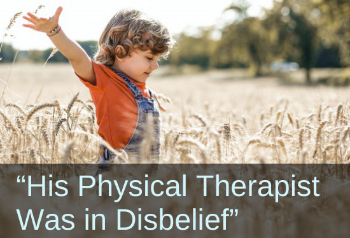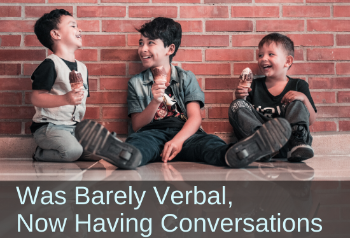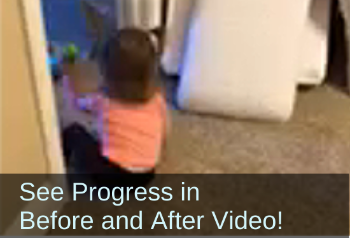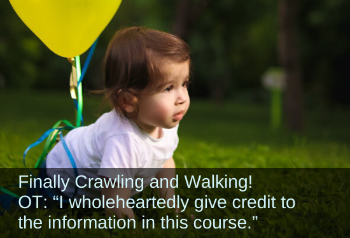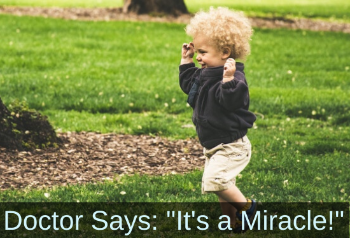Boosting Development with Rhythmic Movements & Reflex Integration
Have you ever wondered why some children sit with their legs folded backward in a "W" position? Or, why a tense pencil grip is so common? Why are some children are often tired, slouching, clumsy, or unable to focus? Why are some irritable and explosive, or withdrawn and sullen?
These issues, and many others such as toe-walking, oral-motor fixations, hypersensitivities, fidgeting, etc., likely stem from gaps in development from early infancy. To address these gaps, we can use innate rhythmic movements and primitive reflex integration movements to give development a second chance to proceed more completely, and to help with many diverse issues. (Scroll down to see how neurodevelopmental movements help in Early Intervention for the 0-to-3 age range).
Because development is progressive, when early movements and skills are not fully developed, compensations often take hold. For example, a child with a retained Tonic Labyrinthine Reflex will likely lack core strength, have poor balance, and may have a tendency to "W" sit. In most cases “W” sitting is a compensation for a lack of core strength and stability. By "W" sitting, the child gains a wider base of support and feels more stable, however, this does not solve the underlying core issues and will not improve the child’s functioning in the long run.
How to spot compensations and give intervention
Using the tools from the Brain and Sensory Foundations program, you can learn to spot compensations like "W" sitting, tense pencil grip, and many others. The course shows you how to assess for retained primitive reflexes and then boost development with targeted movements for improved physical, social-emotional, and cognitive function.
Whenever we see compensations, poor quality of movements, or under functioning, these may be due to missed or incomplete development. The good news is that developmental delays can be greatly helped by doing neurodevelopmental movements. These special movements help us build a foundation for participating in life with much greater ease and effectiveness—for the entire life span.
As Dr. Blomberg taught: You never know how far you can help someone in their development until you try the innate rhythmic and reflex integration movements! See the astounding real-life examples in the case studies highlighted here.
When Gabriel was young and just diagnosed with PDD, his mother was told there was no hope for him and that he should be put in an institution. His mother took the Brain and Sensory Foundations® course and Gabriel quickly learned to focus using these special movements. After some years and various therapies, Gabriel continued to improve and became an honor student in high school! Read the full case study to find out why this boy's mother said the Brain and Sensory Foundations® course was "One of the best things we ever did."
This 4-year-old boy with developmental coordination disorder and previously untreated Torticollis presented with very low muscle tone and poor coordination, spatial awareness, fine motor skills, and gross motor skills. This case study shows how rhythmic movements and primitive reflex integration improved his strength, coordination, and motor planning.
This parent was referred to the Brain and Sensory Foundations First Level course after both private and school-based speech therapy. Her son had severe communication challenges, as well as sleep, behavior, and fine motor challenges. In this case study, you'll see how 8 months of rhythmic movements and primitive reflex integration helped him with his speech, eye contact, behavior, sleep, and more.
Early Intervention Case Studies Using Rhythmic Movements and Reflex Integration
This adorable 20-month-old girl was so hindered by her unintegrated reflexes that she could not walk. Her only way of moving around was to scoot on her bottom. Check out the brilliant work of Melody Edwards, PT in the case study with a before and after video that shows how tools from the Brain and Sensory Foundations® course helped change this child's future in a big way.
This baby's parents were told that their daughter would never crawl. Read this case study to see how a student in the Brain and Sensory Foundation program used those tools at the child's pace to help her not only crawl, but eventually walk.
This little boy with birth trauma could not coordinate his legs to learn how to walk, and was expected to never walk without aid. Diligent physiotherapy and occupational therapy weren't helping. Read this case study to see how this student worked with Sonia Story to tailor a home program of rhythmic movements and foot reflex integration that had him walking in 3 months.
Doing rhythmic movements and primitive reflex integration from the Brain and Sensory Foundations course can make all the difference for children with developmental delay.
Sonia Story, MS has been teaching neurodevelopmental movements since 2006.
She is an honors graduate with a Bachelor's degree in biology/psychology and a Master’s degree in Movement Sciences.
Sonia developed the Brain and Sensory Foundations program to provide comprehensive training in neurodevelopmental movements—combining innate rhythmic movements, play, primitive reflexes, and postural reflexes.
She is the author of The Importance of Reflex Integration and the Evidence eBook, giving the rationale and evidence basis for using neurodevelopmental movements for helping with challenges such as ADHD, Sensory Processing Disorders, anxiety, emotional dysregulation, visual skill deficits, poor social skills, gross and fine motor delays and other neurodevelopmental and behavioral disorders.
Her work is featured in numerous podcasts, summits, and conferences, and in the books Almost Autism: Recovering Children from Sensory Processing Disorder; Special Ed Mom Survival Guide; Family Health Revolution; and Same Journey, Different Paths—Stories of Auditory Processing Disorder.
Sonia’s mission is to help children and families experience the profound benefits of neurodevelopmental and integrative movements for more functional and fulfilling lives.



